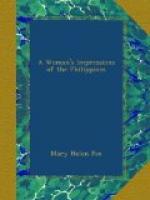Iloilo was a miniature edition of Manila, save that there were more gardens and that there was a rural atmosphere such as is characteristic of small towns in the States. The toy horses and the toy carromatas and quilices were there, and the four-horse wagons with a staring “U. S.” on their blue sides. There were the same dusky crowds in transparent garments, the soldiers in khaki, the bugle calls, and the Stars and Stripes fluttering from all the public buildings.
As Iloilo was not well supplied with hotels, we women were barracked in a new house belonging to the American Treasurer, whose family had not yet arrived from the States, We found our old friend, the army cot, borrowed from the military quartermaster. There was a sitting-room well equipped with chairs and tables. Our meals were obtained from a neighboring boarding-house which rejoiced in the name “American Restaurant,” and was kept by a Filipina. She was a good soul, and had learned how to make cocoanut balls, so that we bade a glad adieu to the bananas and guava jelly.
Our own particular waitress was a ten-year-old child, who said “hello” and smoked a cigar as long as herself. In a moment of enthusiasm one of our number who was interested in temperance and its allied reforms tipped Basilia a whole Mexican media-peseta. When the reformer became aware of Basilia’s predilection for the weed, she wanted her media-peseta back, but Basilia was too keen a financier for that. The media-peseta was hers—given in the presence of witnesses —and she somewhat ostentatiously blew smoke rings when she found the reformer’s eye fixed upon her.
At Iloilo we picked up the word tao, which means “man,” especially “laboring man,” for the Filipinos usually fall back upon the Spanish words caballero and senor to designate the fortunate individuals whose hands are unstained with toil. We had picked up the vernacular of the street carromata in Manila. This is very simple. It consists of sigue, para, derecho, mano, and silla. For the benefit of such readers as do not understand pidgin Spanish, it may be explained that these words signify, respectively, “go on,” “stop,” “straight ahead,” “to the right,” and “to the left.” The words mano and silla mean really “hand” and “saddle”; I have been told that they are linguistic survivals of the days when women, rode on pillions and the fair incubus indicated that she wished to turn either to the side of her right hand or to the skirt side.
By this time we had begun to understand—just to understand in infinitely small proportion—what the old resident Americans meant when they joked about the Philippines as a manana country. When we inquired when a boat would be in, the reply was “Seguro manana”—“To-morrow for sure.” When would it leave? “Seguro manana.” Nothing annoys or embarrasses a Filipino more than the American habit of railing at luck or of berating the unfortunate purveyor of disappointing




